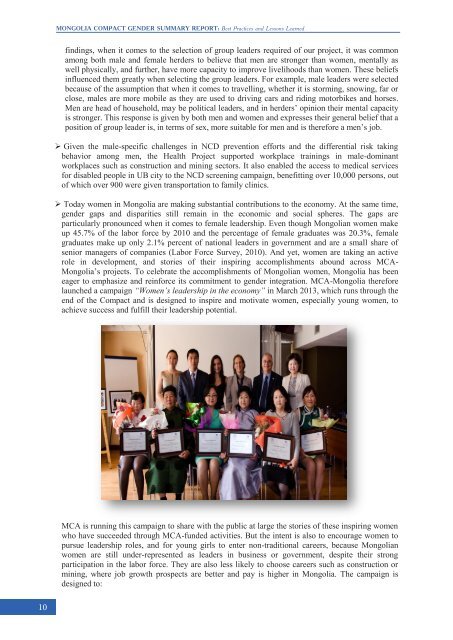Ulaanbaatar 2013
Ulaanbaatar 2013
Ulaanbaatar 2013
Create successful ePaper yourself
Turn your PDF publications into a flip-book with our unique Google optimized e-Paper software.
Mongolia Compact Gender Summary Report: Best Practices And Lessons Learnedfindings, when it comes to the selection of group leaders required of our project, it was commonamong both male and female herders to believe that men are stronger than women, mentally aswell physically, and further, have more capacity to improve livelihoods than women. These beliefsinfluenced them greatly when selecting the group leaders. For example, male leaders were selectedbecause of the assumption that when it comes to travelling, whether it is storming, snowing, far orclose, males are more mobile as they are used to driving cars and riding motorbikes and horses.Men are head of household, may be political leaders, and in herders‟ opinion their mental capacityis stronger. This response is given by both men and women and expresses their general belief that aposition of group leader is, in terms of sex, more suitable for men and is therefore a men‟s job.‣ Given the male-specific challenges in NCD prevention efforts and the differential risk takingbehavior among men, the Health Project supported workplace trainings in male-dominantworkplaces such as construction and mining sectors. It also enabled the access to medical servicesfor disabled people in UB city to the NCD screening campaign, benefitting over 10,000 persons, outof which over 900 were given transportation to family clinics.‣ Today women in Mongolia are making substantial contributions to the economy. At the same time,gender gaps and disparities still remain in the economic and social spheres. The gaps areparticularly pronounced when it comes to female leadership. Even though Mongolian women makeup 45.7% of the labor force by 2010 and the percentage of female graduates was 20.3%, femalegraduates make up only 2.1% percent of national leaders in government and are a small share ofsenior managers of companies (Labor Force Survey, 2010). And yet, women are taking an activerole in development, and stories of their inspiring accomplishments abound across MCA-Mongolia‟s projects. To celebrate the accomplishments of Mongolian women, Mongolia has beeneager to emphasize and reinforce its commitment to gender integration. MCA-Mongolia thereforelaunched a campaign “Women’s leadership in the economy” in March <strong>2013</strong>, which runs through theend of the Compact and is designed to inspire and motivate women, especially young women, toachieve success and fulfill their leadership potential.10MCA is running this campaign to share with the public at large the stories of these inspiring womenwho have succeeded through MCA-funded activities. But the intent is also to encourage women topursue leadership roles, and for young girls to enter non-traditional careers, because Mongolianwomen are still under-represented as leaders in business or government, despite their strongparticipation in the labor force. They are also less likely to choose careers such as construction ormining, where job growth prospects are better and pay is higher in Mongolia. The campaign isdesigned to:Page 10 of 80


